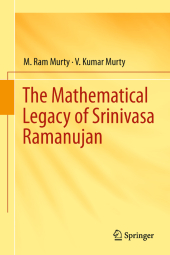 Neuerscheinungen 2014Stand: 2020-02-01 |
Schnellsuche
ISBN/Stichwort/Autor
|
Herderstraße 10
10625 Berlin
Tel.: 030 315 714 16
Fax 030 315 714 14
info@buchspektrum.de |

M. Ram Murty, V. Kumar Murty
(Beteiligte)
The Mathematical Legacy of Srinivasa Ramanujan
2013. 2014. xii, 188 S. 4 Tabellen. 235 mm
Verlag/Jahr: SPRINGER, BERLIN; SPRINGER INDIA; SPRINGER 2014
ISBN: 8132217438 (8132217438)
Neue ISBN: 978-8132217435 (9788132217435)
Preis und Lieferzeit: Bitte klicken
Focusing on a subset of Ramanujanīs significant papers, this book gives an informal account of major developments that emanated from his work in the 20th and 21st centuries. The essays presented here show how Ramanujan shaped the course of modern mathematics.
Srinivasa Ramanujan was a mathematician brilliant beyond comparison who inspired many great mathematicians. There is extensive literature available on the work of Ramanujan. But what is missing in the literature is an analysis that would place his mathematics in context and interpret it in terms of modern developments. The 12 lectures by Hardy, delivered in 1936, served this purpose at the time they were given. This book presents Ramanujanīs essential mathematical contributions and gives an informal account of some of the major developments that emanated from his work in the 20th and 21st centuries. It contends that his work still has an impact on many different fields of mathematical research. This book examines some of these themes in the landscape of 21st-century mathematics. These essays, based on the lectures given by the authors focus on a subset of Ramanujanīs significant papers and show how these papers shaped the course of modern mathematics.
Preface.- Chapter 1. The Legacy of Srinivasa Ramanujan.- Chapter 2. The Ramanujan tau function.- Chapter 3. Ramanujanīs conjecture and l-adic representations.- Chapter 4. The Ramanujan conjecture from GL(2) to GL(n).- Chapter 5. The circle method.- Chapter 6. Ramanujan and transcendence.- Chapter 7. Arithmetic of the partition function.- Chapter 8. Some nonlinear identities for divisor functions.- Chapter 9. Mock theta functions and mock modular forms.- Chapter 10. Prime numbers and highly composite numbers.- Chapter 11. Probabilistic number theory.- Chapter 12. The Sato-Tate conjecture for the Ramanujan tau-function.- Bibliography.- Index.
"This book is based on a number of talks the authors gave at various research institutes. Their aim is to survey some of Srinivasa Ramanujanīs most significant achievements and the developments they have led to over the last decades. ... This volume is suitable as a first introduction to some of Ramanujanīs remarkable and deep ideas." (C. Baxa, Monatshefte für Mathematik, Vo. 180, 2016)
"The authors introduce the reader to the topics through a historical account of the origin and later developments. ... We warmly recommend this book for those who would like to have a glimpse on Ramanujanīs mathematics. Without being lost in the technicalities the reader will get a good look at the shape of many central questions." (Péter Hajnal, Acta Scientiarum Mathematicarum (Szeged), Vol. 80 (1-2), 2014)
"The Murtysī goal ... is to present Ramanujanīs mathematical legacy to a broad audience, and the thrust of the book is a set of eleven chapters discussing exactly that. ... the book will utterly charm you, given its accessibility, style, structure, and depth. Itīs a great pleasure to read, and itīs fine scholarship." (Michael Berg, MAA Reviews, December, 2013)
"This book is an outcome of lectures given by both authors in the last quarter century on various aspects of Ramanujanīs work at research institutions in India and Canada, to audiences ranging from graduate students to senior researchers. Thus the book is written in a style that will appeal to both research mathematicians and students desiring to enter the exciting world of Ramanujanīs mathematics. ... the exposition is good and the book will be of interest to students and researchers ... ." (Krishnaswami Alladi, Mathematical Reviews, September, 2013)


